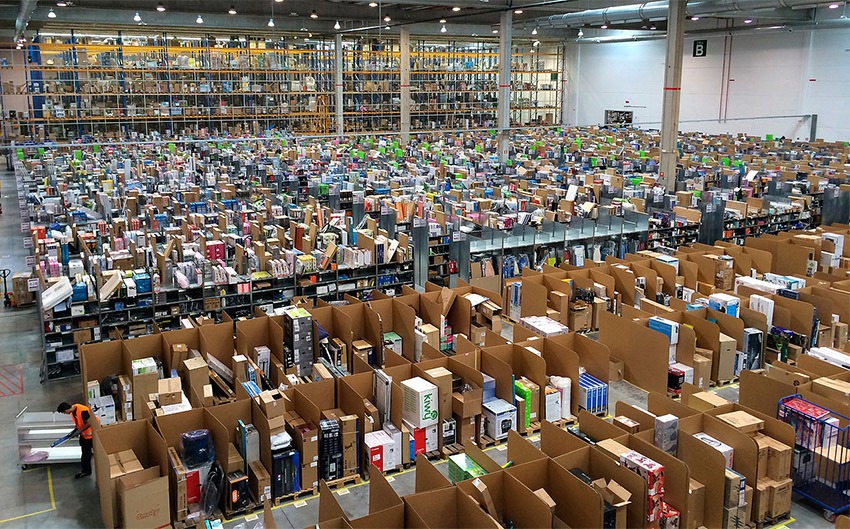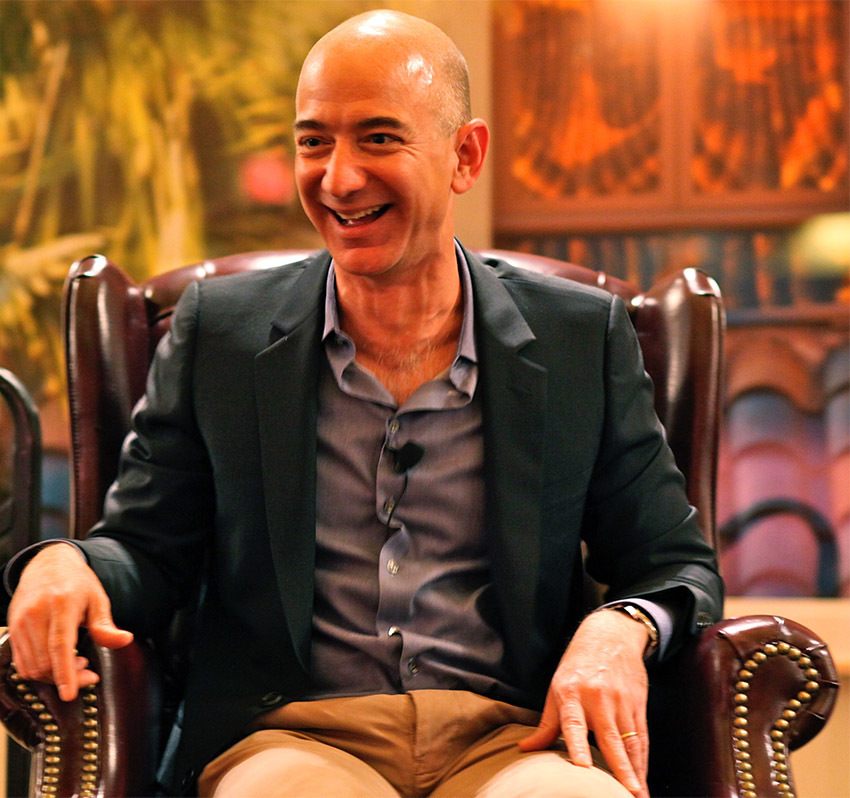Jeff Bezos, Founder and CEO of Amazon, is soon to become the world’s richest person. And, if we are to believe him, he’s just getting started. He’s not the only one who thinks so. RBC Capital’s managing director, Mark Mahaney, estimates Amazon is on track to become the world’s first trillion dollar company. And if that wasn’t enough, Bezos is also an early investor in Google, Twitter, and Uber. He runs his own version of SpaceX called Blue Origin and he is the owner of the Washington Post. In the midst of huge success, Jeff Bezos’ leadership style includes some key lessons we can all learn from.
Whatever you think of Bezos, he should be able to teach us a thing or five about leadership. To get a glimpse of his thinking, the annual Amazon shareholder letters are a good place to start. Bezos has been writing them since Amazon’s IPO in 1997, so there are exactly 20 of them now. I studied them all in detail. Here are five lessons I learned.

1. Vision matters
In his first letter to Amazon’s shareholders, Bezos immediately states he will take a long-term perspective. His company will never choose to optimize quarterly results at the expense of a long-term disadvantage. He also lays the foundations for his vision, which he articulates in 1999:
“Our vision is to use this platform to build Earth’s most customer-centric company, a place where customers can come to find and discover anything and everything they might want to buy online.” (1999)
This vision still holds true today, especially the first part: in everything Amazon does they obsess over the customer. Whether it’s books, Amazon Web Services, or Alexa, they start with the customer and “work backwards from there.”
This customer-centric theme comes back again and again. Here it is in a memo to the team:
“There is no rest for the weary. I constantly remind our employees to be afraid, to wake up every morning terrified. Not of our competition, but of our customers. Our customers have made our business what it is, they are the ones with whom we have a relationship, and they are the ones to whom we owe a great obligation. And we consider them to be loyal to us — right up until the second that someone else offers them a better service.” (1998)
But it doesn’t end with management practices and internal communications. Bezos is even willing to forgo short-term profit over long-term advantage in his commitment to Amazon customers:
“One industry observer recently received an automated email from us that said, ‘We noticed that you experienced poor video playback while watching the following rental on Amazon Video On Demand: Casablanca. We’re sorry for the inconvenience and have issued you a refund for the following amount: $2.99. We hope to see you again soon.’ Surprised by the proactive refund, he ended up writing about the experience: ‘Amazon ‘noticed that I experienced poor video playback…’ And they decided to give me a refund because of that? Wow…Talk about putting customers first.’” (2012)
In theory every company cares about their customers, and some leaders have a vision. Yet Bezos ensures his vision is more than a plaque on the corporate office wall. He walks the customer-centric walk, and also communicates the talk on every possible occasion.
Key takeaways:
- Have a clearly articulated long-term vision.
- Communicate it to both internal and external stakeholders as often as possible.
- Make product decisions based on the vision (which is why the previous point is key, especially in large organizations).

2. Improve your thinking, simplify your message
When you hear someone like Elon Musk, Steve Jobs, or Jeff Bezos describe a new product or initiative, it often sounds obvious and simple. But ask any startup entrepreneur what they’re working on and the answer is often fuzzy and confusing.
This might sound like an irrelevant detail about communication. In fact, this is about thinking and strategy. Most entrepreneurs are not colonizing Mars or building the world’s biggest ecommerce platform. While ambitious, most startup endeavors are less complex.
Why can Elon Musk describe his plan for taking over the Red Planet in plain language, while the average entrepreneur struggles to explain his upcoming product? It’s because masterminds like Musk, Bezos, and Jobs have thought their plans through in detail. They understand what’s required, and they know their target audience. They’ve boiled their complex ideas down to something simple and they know how to position their brand. As Pete Seeger, American folk singer and social activist, once said:
“Any damn fool can make something complex, it takes a genius to make something simple.”
You can see this quality in Bezos’ vision, which still holds true after two decades (!). But it’s also on display in simple value propositions for products. Here’s how he sums up Audible in one sentence, the audiobook company Amazon acquired in 2008:
“Audible makes it possible for you to read when your eyes are busy.” (2013)
And here’s another example of a clearly articulated and understandable goal for designing the Kindle:
“We started by setting ourselves the admittedly audacious goal of improving upon the physical book. We did not choose that goal lightly. Anything that has persisted in roughly the same form and resisted change for 500 years is unlikely to be improved easily. At the beginning of our design process, we identified what we believe is the book’s most important feature. It disappears. When you read a book, you don’t notice the paper and the ink and the glue and the stitching. All of that dissolves, and what remains is the author’s world.” (2007)

If you can’t articulate your plan, it’s a strong signal you need to go back to the drawing board and do more homework.
Key takeaways:
- Clear communication results from deep thinking.
- If you can’t explain something in simple language, you haven’t done enough preparation.
- Use a mental model like the Feynman Technique to improve your understanding of a topic.
3. Staying committed
As Bezos indicated in his first shareholder letter, Amazon cares about the long-term. All decisions get made in that light. Now that Amazon is one of the most valuable companies in the world, it’s easy to laud that strategy in hindsight. It wasn’t always that way:
“‘Amazon, as far as I can tell, is a charitable organization being run by elements of the investment community for the benefit of consumers,’ writes one outside observer. But I don’t think so. To me, trying to dole out improvements in a just- in-time fashion would be too clever by half. It would be risky in a world as fast-moving as the one we all live in. More fundamentally, I think long-term thinking squares the circle. Proactively delighting customers earns trust, which earns more business from those customers, even in new business arenas. Take a long-term view, and the interests of customers and shareholders align.” (2012)
Once you’re on top of the world you can defy criticism and stay true to your principles. But, like any company, Amazon must have experienced countless struggles behind the scenes. Sticking to a long-term vision in the face of such tribulations is hard. It takes guts, conviction, and a plan that makes sense. This makes Bezos’ tradition of attaching the first shareholder to all the later ones even more impressive. He continues to do this every year and can still claim the long-term vision laid out there holds true.
Key takeaways:
- Ensure you have a solid plan (also see the next point).
- Don’t waiver at the first sign of trouble.
- Get a thick skin to deal with criticism.

4. Know your market
Market is the most critical success factor for a new business according to Venture Capitalist Marc Andreessen. His mental model goes something like this (warning: simplifying heavily here):
- If you have a great product but no market, your business is doomed.
- If you have a mediocre product but a huge market, the market will pull the product out of you and you have a good chance at succeeding.
Bezos understands this. From the first letter onwards, he shows a deep understanding of the market, the opportunity, and what it will take to capitalize on it. This is best exemplified by his end notes on the 1999 letter:
“Consider this most important point: the current online shopping experience is the worst it will ever be. It’s good enough today to attract 17 million customers, but it will get so much better. Increased bandwidth will result in faster page views and richer content. Further improvements will lead to “always-on access” (which I expect will be a strong boost to online shopping at home, as opposed to the office) and we’ll see significant growth in non-PC devices and wireless access. Moreover, it’s great to be participating in what is a multi-trillion dollar global market, in which we are so very, very tiny. We are doubly-blessed. We have a market-size unconstrained opportunity in an area where the underlying foundational technology we employ improves every day. That is not normal.”
This section demonstrates he has a clear idea of the current market, but also a clear vision of where it’s headed. He anticipates technical developments like faster internet and mobile devices. He then predicts how those will affect customer behavior by anticipating more online shopping from home.
This is a key skill for a business leader and, to be fair, Bezos has an unfair advantage. Before starting Amazon, he worked at several financial companies on Wall Street. Understanding markets was part of his job. He supposedly made the leap into entrepreneurship after learning in 1994 that the web had grown by 2,300% in one year.
This understanding and observation of markets is often lacking, especially in startups. The team might have a nice idea for a product, and perhaps some hunch about an audience. But a grasp of the market and the trends that influence it is rare to come by.
Key takeaways:
- Understand which market you’re operating in.
- Get a grasp on future trends that are relevant to your business.
- Try to predict how those developments will affect the behavior of your customers.
5. Never miss an opportunity to self-promote
When you read these letters or watch an interview with Bezos, he displays a trait that many great business leaders have: a knack for casual self-promotion, no matter what the occasion.
Whether it’s Howard Schultz (Starbucks), Steve Jobs (Apple), or Jeff Bezos, they always find a way to promote their companies and get you excited about their products. They don’t have to do this: their organizations have large marketing teams to take care of promotion. Yet none of these guys can resist. Whether they’re writing a book, giving an interview, or, like in this case, writing letters to shareholders, they never miss an occasion to promote a new product:
“In addition to Prime Instant Video, Fire TV gives you instant access to over 200,000 movies and TV episodes available a la carte, including new releases like Gravity, 12 Years a Slave, Dallas Buyers Club, Frozen, and more. As a bonus, Fire TV also lets you play high-quality, inexpensive games on your living room TV. We hope you try it out. If you do, let us know what you think. The team would love to hear your feedback.” (2013)

This is just one of many examples. Bezos always promotes Amazon to whatever audience he’s facing. And, being the leader of a gigantic company, this means he gets a lot of these chances, which translates to a lot of free publicity for his company.
Key takeaways:
- As a leader you get visibility, whether that’s in front of a national television audience or your local community.
- Never miss a chance to promote your company or product, but…
- Practice your delivery. It should feel natural, casual, or like an off the cuff joke. Nobody likes someone who’s constantly selling.
Summed up
Reading through two decades of these letters is an amazing experience. You get a sense for the unbelievable growth Amazon has experienced. Most importantly, you get a true glimpse into Jeff Bezos’ leadership style and thinking.
Few people get to build successful companies, even less build one of the most successful ones in the world. Amazon seems set to be with us for a long time. It’s well worth understanding how they operate and where they come from. These letters are a good place to start and there’s a lot more in there than the above five lessons. Dive right into them here and enjoy the journey!

Awesome piece, extremely informational and interesting.